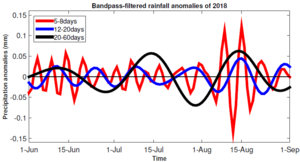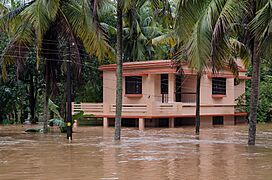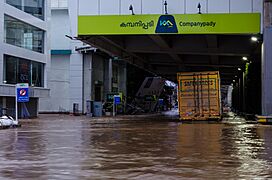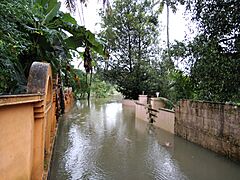2018 Kerala floods facts for kids
| How long: | July 2018 – August 2018 |
On 16 August 2018, severe floods affected the south Indian state Kerala, due to unusually heavy rainfall during the monsoon season. It was the worst flood in Kerala in nearly a century. Over 483 people died, and 15 went missing. About ten lakh (a million) people were evacuated, mainly from Chengannur, Pandanad, Edanad, Aranmula, Kozhencherry, Ayiroor, Ranni, Pandalam, Kuttanad, Malappuram, Aluva, Chalakudy, Thrissur, Thiruvalla, Eraviperoor, Vallamkulam, North Paravur, Chendamangalam, Chellanam, Vypin Island, and Palakkad. All 14 districts of the state were placed on red alert. According to the Kerala government, one-sixth of the total population of Kerala had been directly affected by the floods and related incidents. The Indian government had declared it a Level 3 Calamity, or "calamity of a severe nature". It is the worst flood in Kerala after the great flood of 99 that took place in 1924.
35 out of the 54 dams within the state were opened, for the first time in history. All five overflow gates of the Idukki Dam were opened at the same time; for the first time in 26 years, five gates of the Malampuzha dam of Palakkad were opened. Heavy rains in Wayanad and Idukki caused severe landslides and had left the hilly districts isolated. The situation was regularly monitored by the National Crisis Management Committee, which also coordinated the rescue and relief operations as the dam got opened it has disrupted many lives living nearby.
With the recurrence of flood events in the state in the subsequent years, several studies which ensued explain the manifestation of westward-propagating high frequency tropical atmospheric waves of characteristic phase speed of nearly 12 m/s, which originated near east equatorial Indian Ocean or tropical West Pacific and travelled to the east coast of Africa, and coincide with the same period of extreme rainfall events over Kerala. Moreover, the waves appeared as cyclonic and anti-cyclonic circulations trapped to the equator, which dilated the wind field and transported moisture as it propagated. The waves not only stimulated convection along its trajectory, but also ensured sufficient moisture availability. Therefore, the convective activities which intensified in the mid-troposphere, were the direct consequence of the equatorially-trapped high frequency waves, which played a significant role in driving the recurrent anomalous precipitation in the South Indian state.
Contents
Causes
The southwest monsoon was in 23% excess in Kerala in the year 2018, with August of that year seeing rainfall 96% above normal. On mid-evening of 8 August, Kerala received heavy rainfall which was 116% more than the usual, resulting in dams filling to their maximum capacities. In the proceeding 48 hours, the state received 310 mm (12 in) of rain. Almost all dams had been opened since the water level had risen close to overflow level due to heavy rainfall, flooding local low-lying areas. For the first time in the state's history, 35 of its 54 dams had been opened. One reason is believed to be the levelling of wetlands. The deluge has been considered an impact of global warming.
Independent scientific studies conducted by hydrology experts from IIT Madras, Purdue University, and IIT Gandhinagar concluded that it was the heavy downpour that resulted in the floods, and the dam management. Based on a computer simulation of flood storage and flow patterns by a team of researchers from IIT Madras and Purdue University, it was found that the devastation wrought by the floods cannot be attributed to the release of water from dams. Further, the scientists added that the odds of such floods were "0.06%" and no reservoir management could have considered such scenarios. Hydrology expert from IIT Gandhinagar, Prof. Vimal Mishra, identified four major factors for the floods. Unexpected above normal downpour, extreme rainfall events occurring almost across Kerala during the season, over 90% reservoir storage even before the onset of extreme rainfall events, and finally, the unprecedented extreme rainfall in the catchment areas of major reservoirs in the state led to the disaster. The prime reason for the anomalous rainfall in 2018 is the high-frequency mixed Rossby-gravity waves in the mid-troposphere triggered by the synoptic disturbances of the tropical Pacific. These high-frequency waves manifested as cyclonic and anticyclonic circulations and dilated the wind field to establish zones of convection in the tropics, as they propagated across the Indian Ocean basin. Although the Madden-Julian Oscillation phase with 20-to-40-day period has favored convection in the tropics, the high-frequency mode correlates better with the anomalous precipitation during the intervals of extreme events. Independent only private weather firm in Kerala Metbeat Weather LLP early forecast floods. The team of meteorologists said multiple weather systems caused the Flood situation. global warming and climate change are the reasons for extream rainfall in shot period.
Expert bodies like the Central Water Commission have corroborated the findings by scientists from IIT Madras, Purdue University and IIT Gandhinagar.
A report by Adv. Jacob P. Alex, an amicus curiae appointed by the Kerala high court, alleged that the devastating floods of 2018 were the result of bad dam management by the state government. All 79 dams in the state were maintained with the objective to generate hydroelectricity or irrigation and controlling flood wasn't their purpose, amicus curiae Jacob P Alex's report highlighted. "The major concern of the dam operators was to maximise reservoir levels, which conflicted with the flood control purpose for which the dams could be utilised. The 'flood cushion' of reservoirs – the storage space earmarked in dams to absorb unanticipated high flows – needed review as per the latest guidelines," Alex wrote in his report. "Sudden release of water simultaneously from different reservoirs, during extreme rainfall aggravated the damage,"it said adding that various alerts—blue, orange and red—had been issued not in accordance with the EAP guideline. "No proper follow-up action and effective precautionary steps (especially for evacuating people and accommodating them in safe location) were taken after issuance of Red Alert," it said. However, Honorable high court of Kerala cleared on 20 August 2019 that the amicus curiae report is not accepted and court cannot be used for political battles and arguments.
The Government of Kerala argued in the Supreme Court that the very sudden release of water from the Mullaperiyar Dam by the Tamil Nadu government was one of the reasons for the devastating flood in Kerala. The Tamil Nadu government rejected the argument, saying that Kerala suffered the deluge due to the discharge of excess water from 80 reservoirs across Kerala, spurred by heavy rains from within the state; It also argued that the flood surplus from the Idukki dam is mainly due to the flows generated from its own independent catchment due to unprecedented heavy rainfall, while the discharge from Mullaperiyar dam was significantly lesser. Though it is difficult to attribute any single event to climate change, its possible role in causing the heavy rainfall event over Kerala cannot be ruled out.
Impacts
Over 489 people died, 15 are missing and 140 are hospitalized, while The Economic Times reported that 33,000 people were rescued. The Kerala State Disaster Management Authority had placed the state on red alert as a result of the intense flooding. A number of water treatment plants were forced to cease pumping water, resulting in poor access to clean water, especially in northern districts of the state. Over 3,274 relief camps were opened at various locations to accommodate the flood victims. It is estimated that 1,247,496 people found shelter in such camps. The flooding affected hundreds of villages, destroyed an estimated 10,000 km (6,200 mi) of roads and thousands of homes have were damaged or destroyed. The Government cancelled Onam celebrations and reallocated the funds to relief efforts.
On 12 August, Cochin International Airport, India's fourth busiest in terms of international traffic, and the busiest in the state suspended all operations until 29 August, following runway flooding. All schools throughout the state were closed, and tourists had been dissuaded or prohibited from some districts due to safety concerns. The Kochi Metro briefly closed on 16 August, and later offered free service to aid those affected by the flooding. Due to heavy rain and rising water levels the southern railway had suspended train services on the Thiruvananthapuram-Kottayam-Ernakulam and Ernakulam-Shoranur-Palakkad sections.
Rescue


Rescue operation at government levels
Being instructed by ISRO the Cabinet Secretary, senior officers of Defence Services, NDRF, NDMA and secretaries of Civilian Ministries conducted meetings with Kerala Chief Secretary. Following the decisions taken during these meetings, the centre launched massive rescue and relief operations. In one of the largest rescue operations 40 helicopters, 31 aircraft, 182 teams for rescue, 18 medical teams of defence forces, 90 teams of NDRF and 3 companies of Central Armed Police Forces were pressed into service along with over 500 boats and necessary rescue equipments.The government provided necessary supplies to those who needed help and conducted many rescue operations.
Rescue operation by public
WhatsApp groups sprung up as Control Centers that coordinated help and support across various areas. A good majority of the population was involved in arranging supplies and help material in various ways, which helped the country in staying calm.
Rescue operation by fishermen
According to the government's estimate, a total of 4,537 fishermen communities from Kollam and Thiruvananthapuram districts participated in the rescue operation with 669 fishing boats. They managed to rescue more than 65,000 people from various districts. Chief Minister Pinarayi Vijayan honoured the fishermen. The Fisheries Minister J. Mercykutty Amma said that the government would provide financial aid to repair the fishing boats which were partially damaged in the rescue operations while new ones will be provided for those boats which were completely destroyed. According to estimates, seven boats were completely destroyed, while 452 were partially destroyed.
Relief and monetary aid
Government, NGOs and NPOs
- The Government of Kerala started a donation website for flood victims. As of 7 January 2020[update], approximately ₹4,740 crore (US$639.68 million) was collected from the public including organisations, corporate firms and famous personalities.
- The Prime Minister of India, Narendra Modi announced a sum of ₹500 crore (US$73.11 million) as interim relief for Kerala on 18 August 2018. This is in addition to ₹562.45 crore (US$82.24 million) already made available in SDRF of the State and ₹100 crore (US$14.62 million) announced on 12 August 2018 by the Home Minister. The central government also said in its press release that this ₹600 crore (US$87.73 million) is only the advance assistance and that additional funds will be released by the NDRF when an inter-ministerial team visits again and assesses the damage. The central government, in one of the largest rescue operations, deployed 40 helicopters, 31 aircraft, 500 boats, 182 rescue teams and 18 medical teams of defence forces, 58 teams of NDRF and 7 companies of Central Armed Police Forces. Together they saved over 60,000 human lives.
- European Union announced an assistance of ₹1.53 crore (€190,000) in aid funding to the Indian Red Cross Society for providing relief to flood-affected people in Kerala.
- The Governments of Maldives, Pakistan, Thailand and Qatar extended condolences and offered humanitarian assistance and monetary aid.
- In a gesture of solidarity with the State government's flood relief efforts, the Kerala Catholic Bishops' Council (KCBC) donated ₹1 crore (US$146,221.28) to the Chief Minister's Distress Relief Fund. KCBC President and Archbishop of Thiruvananthapuram Latin Archdiocese, Bishop Dr. Soosa Pakiam, presented the contribution to the Chief Minister's office. The Archbishop also mentioned that Caritas India, the social service wing of CBCI, along with the Catholic Churches of Kerala is undertaking special relief projects like housing to aid the victims.
- The KCBC in its Winter Session reviewed that as of December 2018 the Catholic Churches of Kerala has spent ₹164 crore (US$23.98 million) for flood reliefs and that 36.5 acres of land was mobilized for the landless with the cooperation of various dioceses and its religious congregations. The Winter session reviewed rehabilitation progress the Church is carrying out for the flood victims.
- Mata Amritanandamayi Math donated ₹10 crore (US$1.46 million) to the Kerala Chief Minister's Distress Relief Fund, in addition to providing relief materials and helping in rescue operations.
- The Guruvayur Devaswom Board donated ₹5 crore (US$731,106.38) to the Chief Minister's Distress Relief Fund (CMDRF). However on a case filed by its devotee, the Kerala High Court, in December 2020, ruled that the ₹10 crore (US$1.42 million) the state government received from the board (including donations from 2018 and 2019 floods) should be returned. The court argued that temple funds should prioritize the development of the shrine and its allied services. The Guruvayur Devaswom Board challenged this decision in the Supreme Court, which has ordered a status quo on the matter until further review.
- People's Foundation, an NGO based in Calicut, with the support of Ideal Relief Wing Kerala had served with 37,000 volunteers for rescue and hygiene operations. Their volunteers had cleaned 11,139 houses and conducted 494 relief camps for flood victims. They also committed housing projects for the victims.
- A fundraising campaign started via the Federation of Malayalee Associations of Americas (FOMAA) 2018–2020 leadership, later migrating to Facebook procured over 260 donors from across the world and was able to raise enough money to build more than forty homes and dedicate various villages across districts of Kerala.
- A fundraising campaign started on Facebook by charitable organisations Knanaya Catholic Yuvajanavedhi of Chicago and Care and Share along with a person named Arun Simon Nellamattom and others raised and donated US$1.6 million to Kerala Chief Minister's Distress Relief Fund.
- IsraAid, an Israeli NGO sent relief workers to distribute supplies and assess needs for clean water, sanitation, and psychological care.
- Many Members of Parliament, Members of State Legislative Assemblies and Councils, civil servants and Government employees across the country have also donated their one month's salary and/or allowances towards Kerala Chief Minister's Distress Relief Fund.
- Chief Ministers of all the states (and Delhi) pledged monetary aid from their respective state funds in addition to dispatch of various relief materials such as potable water, blankets, packed food, rice, water-purifying machines, daily-use and healthcare products. Monetary contributions are listed below:
| State/union territory | Amount | Refs |
|---|---|---|
| Andhra Pradesh | ₹10 crore (US$1.46 million) | |
| Arunachal Pradesh | ₹3 crore (US$438,663.83) | |
| Assam | ₹3 crore (US$438,663.83) | |
| Bihar | ₹10 crore (US$1.46 million) | |
| Chhattisgarh | ₹3 crore (US$438,663.83) | |
| Delhi | ₹10 crore (US$1.46 million) | |
| Goa | ₹5 crore (US$731,106.38) | |
| Gujarat | ₹10 crore (US$1.46 million) | |
| Haryana | ₹10 crore (US$1.46 million) | |
| Himachal Pradesh | ₹5 crore (US$731,106.38) | |
| Jharkhand | ₹5 crore (US$731,106.38) | |
| Karnataka | ₹10 crore (US$1.46 million) | |
| Madhya Pradesh | ₹10 crore (US$1.46 million) | |
| Maharashtra | ₹20 crore (US$2.92 million) | |
| Manipur | ₹2 crore (US$292,442.55) | |
| Meghalaya | ₹1 crore (US$146,221.28) | |
| Mizoram | ₹2 crore (US$292,442.55) | |
| Nagaland | ₹1 crore (US$146,221.28) | |
| Odisha | ₹10 crore (US$1.46 million) | |
| Puducherry | ₹1 crore (US$146,221.28) | |
| Punjab | ₹5 crore (US$731,106.38) | |
| Rajasthan | ₹10 crore (US$1.46 million) | |
| Tamil Nadu | ₹10 crore (US$1.46 million) | |
| Telangana | ₹25 crore (US$3.66 million) | |
| Tripura | ₹1 crore (US$146,221.28) | |
| Uttar Pradesh | ₹15 crore (US$2.19 million) | |
| Uttarakhand | ₹5 crore (US$731,106.38) | |
| West Bengal | ₹10 crore (US$1.46 million) | |
| Total | ₹212 crore (US$31 million) | |
Housing projects for flood survivors
| Organization | Details of no. of houses and allied services | Wherewithal | Refs |
|---|---|---|---|
| Act On | 300 houses | ₹6 crore (US$877,327.66) | |
| Changanassery Social Service Society (CHASS)social service wing of the Archeparchy of Changanassery | Renovation of 1000 houses, constructing 1000 rainwater storage facilities, 100 water purification plants, 1000 flood-resilient toilets and waste treatment plants for households of flood hit Kuttanad region | ₹100 crore (US$14.62 million) | |
| Federation of Malayalee Associations of Americas – FOMAA | 250 houses | ||
| Joy Alukkas | 250 newly built houses each with 600sq.feet | ₹15 crore (US$2.19 million) | |
| KCARE (Kerala Cooperative Alliance to Rebuild Kerala) | Renovation /building of 1500 houses | ₹75 crore (US$10.97 million) | |
| Kerala Catholic Bishops' Council(KCBC) in association with Caritas India | Construction of 2620 new houses and its land allocation renovation of 6630 partially destroyed houses, 4226 latrines and 4744 wells | ₹250 crore (US$36.56 million) | |
| Muslim Jamaath | Rebuilding 1000 damaged houses via Chief Minister's distress relief fund | ₹50 lakh (US$73,110.64) | |
| Muthoot Group | 200 newly built houses each with 550sq.feet | ₹10 crore (US$1.46 million) | |
| Peoples Foundation | Construction of 305 houses, renovation of 888 houses, and 34 drinking water projects | ₹25 crore (US$3.66 million) | |
| Total | __ | ||
Corporate and individual
- Dr. Azad Moopen, chairman and managing director of Aster DM Healthcare has donated ₹2.5 crore (US$355,011.27) to the Kerala Chief Minister's relief fund and another ₹12.5 crore (US$1.78 million) for rebuilding houses in flood affected areas.
- Major oil companies of India such as BPCL, HPCL, IOCL, and others have collectively donated ₹25 crore (US$3.66 million) to the Kerala Chief Minister's Distress Relief Fund, in addition to providing relief materials and helping in rescue operations.Oil and Natural Gas Corporation (ONGC) donated US$1million to Prime Ministers Relief Fund and sent relief teams with medical professionals and three helicopters for rescue and logistics support.
- Reliance Foundation chairperson Nita Ambani has announced a donation of ₹21 crore (US$3.07 million) to the Kerala Chief Minister's Distress Relief Fund, besides relief materials worth around ₹50 crore (US$7.31 million).
- Adani Foundation, the CSR, sustainability and community outreach arm of the Adani Group, has committed to provide ₹1 crore (US$146,221.28) for immediate relief and another ₹1 crore (US$146,221.28) is earmarked for rehabilitation and resettlement.
- Star India, its parent company 21st Century Fox and their employees have collectively donated ₹5 crore (US$731,106.38).
- Canara Bank, a leading nationalised public sector bank, donated ₹5.01 crore (US$732,568.6) towards Kerala Chief Minister's Disaster Relief Fund. Besides this, 10 tonnes of rice packets were also donated under CSR.
- Bollywood actor Sushant Singh Rajput had donated ₹1 crore (US$146,221.28) to the Kerala Chief Minister's relief fund on behalf of an Instagram fan. He also sent his team for relief activity in Kerala. Vidya Balan, Siddharth Roy Kapoor, Shah Rukh Khan, Amitabh Bachchan, Abhishek Bachchan, Alia Bhatt, Siddharth Suryanarayan, Rishi Kapoor, Vidhu Vinod Chopra, Akshay Kumar, Suriya and Resul Pookutty are others from film industry to have contributed to Kerala Chief Minister's relief fund.
- KP Hussain, chairman of Fathima Healthcare Group, has donated ₹1 crore (US$146,221.28) to the Kerala Chief Minister's relief fund, and another ₹4 crore (US$584,885.11) for medical relief aid.
- Doctor, entrepreneur, and philanthropist Shamsheer Vayalil donated ₹50 crore (US$7.31 million) for the relief of flood victims by setting up a project to fight housing, education and healthcare issues.
- UAE-based Indian businesses have donated ₹18.85 crore (US$2.76 million) so far to Khalifa Bin Zayed Al Nahyan Foundation's relief fund. Among those to donate were Indian businessmen Yusuff Ali M.A., chairman and managing director of LuLu Group International, and Dr. B. R. Shetty, founder and chairman of NMC Health.
- Bombay High Court directed Galpha Laboratories to deposit a sum of ₹1.5 crore (US$219,331.91) towards the Kerala Chief Minister's Fund after losing trademark infringement case filed by Glenmark Pharmaceuticals. The court initially said that Galpha Laboratories would have to pay the sum to Glenmark Pharmaceuticals. However, Glenmark Pharmaceuticals requested the court to direct Galpha Laboratories to deposit the sum in an NGO. Following this, the court directed that the money is to be deposited in the Kerala Chief Minister's Fund.
- Indian cricket team captain, Virat Kohli, dedicated his team's test win over England at Trent Bridge to the flood victims of Kerala. The Indian team has donated match fees for Kerala flood victims.
- Chipsan Aviation provided 3 helicopters for rescue & Relief operations.
- CHD Group, a Mangalore-headquartered public health organization led by Dr. Edmond Fernandes, MD has been working tirelessly in championing the needs of tribal communities, adivasis and other backward areas in optimizing their healthcare post disaster.
Rainfall data
Rainfall departures
Week by week departures from normal:
Cumulative rainfall by district
Percentage increase in rainfall compared to normal.
| District | Rainfall (mm) |
Normal (mm) |
% increase |
|---|---|---|---|
| Alappuzha | 1648.1 | 1309.5 | 20.54% |
| Ernakulam | 2305.9 | 1606.0 | 43.58% |
| Idukki | 3211.1 | 1749.1 | 83.58% |
| Kannur | 2450.9 | 2234.9 | 9.66% |
| Kasaragod | 2549.94 | 2489.1 | -2.44% |
| Kollam | 1427.3 | 985.4 | 44.84% |
| Kottayam | 2137.6 | 1452.6 | 32.04% |
| Kozhikode | 2796.4 | 2156.5 | 22.80% |
| Malappuram | 2529.8 | 1687.3 | 49.93% |
| Palakkad | 2135.0 | 1254.2 | 70.22% |
| Pathanamthitta | 1762.7 | 1287.5 | 36.90% |
| Thiruvananthapuram | 920.8 | 643.0 | 43.07% |
| Thrissur | 1894.5 | 1738.2 | 8.99% |
| Wayanad | 2676.8 | 2167.2 | 23.51% |
| Kerala | 2226.4 | 1620.0 | 37.43% |
Immediate drought after the flood
A few days after receiving one of the highest rainfalls in century, Kerala was caught under the threat of severe drought. Water level in wells, ponds and rivers have recorded lowest levels and some wells even collapsed. Chief minister Pinarayi Vijayan has directed the State council for Science, Technology & Environment to carry out studies on the phenomenon after floods across the state and suggest possible solutions to the problem.
A.B. Anita, executive director, Centre for Water Resource Development Management (CWRDM), an autonomous research institution under the State government, said heavy run-off of the top soil in the upland areas and the siltation in the rivers were the reasons for the falling water level. The top soil in the hills and upland areas had been removed in the flash floods to a depth of up to two metres in many places. As the top soil was shaved off, it ruined the hills' capacity to sponge in rainwater, she said. Ms. Anita cited ecological destruction caused by deforestation, harmful land use in the upland areas and sand mining in the streams and rivers as having contributed to the top soil run-off and siltation. This was exacerbated by the impact of climate change at the macro level.
Echoing her views, experts at the National Institute of Technology, Calicut, (NIT-C) said it was usual for the water level in the rivers and domestic wells to fall after fluvial floods. "Normally, a river flows through the sand of its own bearing till the mouth. However, this time the discharge has been full, taking the sand and the rocks in the youth-stage along with the floods. So the water level in the rivers comes down. And when the river water level is reduced, the groundwater table also does not get replenished since the rivers and groundwater table are connected," said K. Saseendran, geologist and professor at the NIT-C.
See also
- Kerala floods
- Great flood of 99
- 1341 Floods in Kerala
- 2019 Kerala floods
- 2020 Kerala floods
- 2018 in Kerala
- 2004 Indian Ocean earthquake and tsunami












